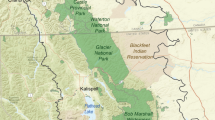Abstract
Contagious spatial patterns were shown to exist in the landscape of front-yards in street sections of Hochelaga-Maisonneuve, Montréal. Neighbour mimicry was hypothesized as the mechanism behind this pattern (Zmyslony and Gagnon 1998). To assess the role of spatial environmental factors in structuring this pattern, we carried out a path analysis on the front-yard landscape with five spatial factors: relative distance, street side, width, depth and type of front-yard. We removed all non-significant factors from our model with simple Mantel tests and untangled the common spatial component from the relationship between spatial factors and front-yard landscape with partial Mantel tests. We then used path analysis to evaluate the relative importance of all significant spatial factors in structuring front-yard landscape and to determine the r 2 (% of landscape variation explained by spatial factors). Results showed that (1) among all spatial environmental factors, distance (proximity) remained the best predictor of front-yard vegetation – distance alone explained an average of 20% of the landscape variation of a street section, (2) depth, width and type of front-yard also structured the front-yard landscape independently of distance, (3) front-yard landscape expresses greater similarity within the same side of a street section, and (4) in two street sections of Hochelaga-Maisonneuve, spatial factors predicted over 40% of the landscape variation. This suggests (1) that landscape contagion exists also in highly humanized environments and (2) that the mimicry phenomenon was induced not only by proximity, but also by similar environmental conditions in same side street sections and whole street sections. Finally, we suggest that street sections are a very useful and appropriate unit of analysis of urban ecosystems.
Similar content being viewed by others
References
Burgess, E.W. 1925. The growth of the city: an introduction to a research project. The City, University of Chicago Press, Chicago. pp. 47–62.
Caldwell, L.K. 1990. Landscape, law and public policy: conditions for an ecological perspective. Landscape Ecol 5: 3–8.
Cooper, C.C. 1975. Easter Hill Village: Some Social Implications of Design. The Free Press, New York, 337 p.
Dansereau, P. 1984. Les repères de l'éco-développement. Livro de Homenagem a Orlando Ribiero 1: 87–89.
Dorney, J.R., Guntenspergen, G.R., Keough, J.R. and Stearns, F. 1984. Composition and structure of an urban woody community. Urban Ecol. 8: 69–90.
Eveillard, C. 1991. Montréal côté jardins. Ms Thesis, Université de Montréal, 122 p.
Gower, J.C. and Legendre, P. 1986. Metric and Euclidean properties of dissimilarity coefficients. J Classification 3: 5–48.
Jim, C.Y. 1993. Trees and landscape of a suburban residential neighbourhood in Hong Kong. Landscape Urban Plann 23: 119–143.
Leduc, A., Drapeau, P., Bergeron, Y. and Legendre, P. 1992. Study of spatial components of forest cover using partial Mantel tests and path analysis. J Veg Sci 3: 69–78.
Legendre, L. and Legendre, P. 1984. Écologie numérique: La structure des données écologiques. Collection d'Écologie, 13. Masson, Paris et les Presses de l'Université du Québec.
Legendre, P. and Fortrin, M.-J. 1989. Spatial pattern and ecological analysis. Vegetatio 80: 107–138.
Legendre, P. 1985. The ‘R’ package for multivariate data analysis. Département de sciences biologiques, Université de Montréal, Montréal, Canada.
Mantel, N. 1967. The detection of disease clustering and a generalized regression approach. Cancer Res 27: 209–220.
Naveh, Z. 1995. Interactions of landscapes and cultures. Landscape Urban Planning 32: 43–54.
Naveh, Z. 1990. Landscape ecology as a bridge between bioecology and human ecology 173 pp. In Cultural Aspects of Landscape. Edited by H. Svoboda, Pudoc, Wageningen.
Miller, R.G. 1966. Simultaneous Statistical Inferences. McGraw-Hill, New York, U.S.A.
Mongeau, P. and Tremblay, J. 1988. Règles et stratégies pour exercer un leadership efficace ou l'art d'influencer sans remords. Editions Libre Expression, Montréal, 135 pp.
Nantel, P. and Neumann, P. 1992. Ecology of Ectomycorrhizal-Basidiomycete communities on a local vegetation gradient. Ecology 73: 99–117.
Pielou, E. C. 1984. The Interpretation of Ecological Data. John Wiley, New York, 263 pp.
Plante S. and Simoneau, L. 1986. Hochelaga-Maisonneuve, Atlas socio-économique. Atelier d'histoire Hochelaga-Maisonneuve, Montréal.
Richards, N.A., Mallette, J.R., Simpson, R.J. and Macie, E.A. 1984. Residential greenspace and vegetation in amature city: Syracuse, New York. Urban Ecol 8: 99–125.
Routaboule, D., Asselin, V. and Eveillard, C. 1995. Le paysage de l'intérieur ou expressions paysagères résidentielles dans l'île de Montréal. Report to the Canadian Mortgage and Housing Corporation, Ottawa, 116 pp.
Rowntree, R.A. 1988. Special Issue ‘Ecology of the Urban Forest, Part III: Mapping, Preferences and Planning’. Landscape and Urban Plann., 15: 1–224.
Sanders, R.A. 1984. Some determinants of urban forest structure. Urban Ecol 8: 13–27.
Sanders, R.A. and Stevens, J.C. 1984. Urban forest of Dayton, Ohio: A preliminary assessment. Urban Ecol. 8: 91–98.
Skolimowski, H. 1984. Eco-philosophy: Designing new tactics for living. Marion Boyars, London.
Smouse, P.E., Long, J.C. and Sokal, R.R. 1986. Multiple regression and correlation extensions of the Mantel test of matrix correspondence. Syst. Zool 35: 627–632.
Sokal, R.R. and Rohlf, F.J. 1981. Biometry. 2nd ed. W.H. Freeman, San Francisco.
Teilhard De Chardin, H. 1955. Le phénomène humain. Éditions du Seuil, Paris, 348 pp.
Whitney, G.R. and Adams, D.A. 1980. Man as a maker of new plant communities. J. Appl Ecol 17: 431–448.
Zmyslony, J. and Gagnon, D. 1998. Residential management of urban front-yard landscape: A random process? Landscape Urban Plann 40: 295–307.
Zmyslony, J. 1997. La contagion du paysage des jardins-façades urbains: démonstration, modélisation et théorisation. Ph.D. Thesis. Université du Québec à Montréal, 142 pp.
Zonneveld, I.S. 1989. The land unit–A fundamental concept in landscape ecology, and its applications. Landscape Ecol 3: 67–86.
Zonneveld, I.S. 1982. Landscape ecology, a science or a state of mind. pp. 9–15. In: Perspectives in landscape ecology, Edited by Tjallingi, S.P. and de Veer, A.A., Pudoc, Wageningen.
Zube, E.H. 1987. Perceived land use patterns and landscape values. Landscape Ecol 1: 37–45.
Zube, E.H., Sell, J.L. and Taylor, J.T. 1982. Landscape perception: research, application and theory. Landscape Plann 9: 1–33.
Author information
Authors and Affiliations
Rights and permissions
About this article
Cite this article
Zmyslony, J., Gagnon, D. Path analysis of spatial predictors of front-yard landscape in an anthropogenic environment. Landscape Ecology 15, 357–371 (2000). https://doi.org/10.1023/A:1008160131014
Issue Date:
DOI: https://doi.org/10.1023/A:1008160131014




